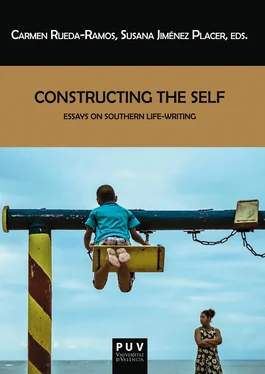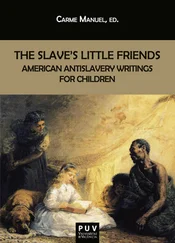Race issues and reconciliation are also prominent in the following essay, where Ineke Bockting elaborates a persuasive argument around the table of brotherhood, which traces the evolution of the American Dream as perceived by different southern writers in their autobiographical narratives. Using Martin Luther King Jr.’s famous dream of race integration as a starting point for her discussion, Bockting turns to C. Vann Woodward’s postulates in The Burden of Southern History to offer an overview of “the American founding myths that form the background of the American Dream, [and] against which the South stands out as if it were a foreign nation.” According to Bockting, King’s dream of brotherhood, materialized in “the powerful visual, olfactory and gustatory imagery of the dinner table,” depended precisely on the possibility of bringing these myths to the South. But the obstacles that the dream of a dinner table of brotherhood had to overcome in the South were too many and too deep, as evinced in Malcolm X’s response to King in “The Ballot or the Bullet,” and as further reflected in the autobiographical experiences recorded by writers and activists. Bockting traces references to those experiences in the life narratives of William Alexander Percy, Langston Hughes, Lillian Smith, Anne Moody and Marita Golden. Images of food and dinner tables figure prominently in some of these works, as Bockting shows, but mostly as a realistic counterpoint to King’s dream which seems to end up in fatalistic disillusionment. Bockting also comments on the Obama administration, as the first African American US President in history, in relation to the Dream “of a family dinner table of brotherhood” and harmony.
Taking as a starting point Philippe Lejeune’s autobiographical pact between author, narrator and protagonist, who are identified as one, Part 3 “Authors, Narrators and Fictionalized Selves” deals with the fracture of the pact and the thin line between autobiography and fiction. This section considers the intrusion of fiction and fictionalized selves in autobiographical writings, as well as the inclusion of autobiographical elements in the novels of important southern authors. Peggy Whitman Prenshaw’s article centers on Lejeune’s triad, which she calls “memoir’s characters,” and her discussion of the presence of those characters in different life narratives by southern women serves as a framework for the rest of the papers in this section. Using Mary Karr’s insightful reflections on the issues that usually complicate the task of memoir writers, Prenshaw engages in a discussion about the components of voice and the strategies several life narrators have used to manipulate the interplay of this “trinity” of voices and thus condition the credibility of their life writings. Prenshaw’s characters are the “self-aware writer,” the “created narrator” and the “objectified, characterized self” who acts as protagonist. Prenshaw points to the centrality of the narrator’s voice as the main means of expression of “the interpreted self, the composed self presented to the reader,” and argues that the other two, “the protagonist of the narrative, the younger characterized self” and “the present-moment laboring writer,” function just as dramatic foils to the “transformed self” represented by the narrator. In Prenshaw’s essay, passages from autobiographies written by southern women in different periods of literary history serve to illustrate this discussion, which is further animated by a variety of reflections on related topics such as truth telling, the use of devices typical in life-writing, the contribution of sensory details to enhance a narrative’s credibility, or the effects of the “steady cultural change in what society regards as acceptable for public exposure” on women’s life-writing. Prenshaw notes that “in the works of Mary Karr, Ellen Douglas, and many other southern women autobiographers, we may read memoir’s characters as a trinity leaning toward oneness.”
Prenshaw also acknowledges that “[i]t is not unusual to hear or read remarks by writers that ‘deeper truths’ may be told in fiction than in memoir” with the construction of a fictionalized self. The following essays in this section further explore this idea. Thomas L. McHaney draws on The Sound and the Fury to discuss Faulkner’s tangential relationship with autobiography. In contrast to other essays in this collection, which deal with the effects of the intrusion of fiction in memoir writing, T. McHaney’s traces the presence of what he calls Faulkner’s “embellished autobiography” in his fiction. He argues that “the writer’s propensity for biographical application and exaggeration” was evident even in his early poetry, long before Sherwood Anderson had advised him to “embroider autobiography,” as Faulkner himself explained to his mother in a March 1925 letter from New Orleans. According to T. McHaney, the revelation of Faulkner’s “long-suppressed letters to his parents” in 1992 threw renewed light on the presence of autobiographical elements in his fiction. In his analysis of the parallels between the author’s factual self and his fictionalized self, T. McHaney identifies new autobiographical details in the depiction of Quentin Compson by drawing a revealing comparison between this character’s last day and evidence provided by one of Faulkner’s letters to his mother dated June 2, 1918, when the writer was living in New Haven. Thomas McHaney offers a detailed description of the events depicted in this letter and an analysis of the significance of its historical context for the southern writer. He also argues that Faulkner “toyed with autobiography to make fiction” and even “threw up a very fictional screen, or a series of fictional screens, to hide the details of his biographical inventions and his real life from reporters and biographers.”
Gérald Préher turns to Richard Ford to delve into the writer’s own ambivalence towards his southern self and autobiography in general. In spite of his early admiration for Faulkner’s literary output, Ford tried to escape the looming shadow of the universal writer from Mississippi as well as the label of southern writer. Préher suggests that Ford’s work, like that of William Faulkner, “confirm[s] James Olney’s idea that ‘[w]hite writers from the South seem for the most part unwilling to write autobiography without veiling it or presenting it as fiction.’” (140). While admitting that the autobiographical impulse in Ford is mainly “incidental” and often “presented behind a veil,” in his contribution Préher explores how Ford’s southern self infiltrates his fiction and non-fiction. By providing examples of autobiographical elements in Ford’s novels, Préher seeks to show what he considers paradoxical in the writer, his love-hate relationship with the South—particularly in The Sportswriter , his third novel and the first of his Bascombe trilogy. In his analysis of The Sportswriter , Préher uses interviews and Ford’s essays in order to show the parallelisms between the author’s personal life and his fictional self, Frank Bascombe. Despite Ford’s claims denying his interest in the past and the South, the character of Frank Bascombe is, according to Préher, an example of the writer’s own ambiguity and a reflection of his inner struggle with his southern self. The Bascombe novels represent, therefore, a form of “fictional autobiography” in which “the narrative is always self-reflective [and] the past is mediated through the present.” Acknowledging the freedom that fiction provides for many southern white writers when they look at the past, Préher contends that “[f]ictionalizing an actual event, relocating it in a narrative, enables Ford to become doubly independent: from the South and from the past.”
Читать дальше












